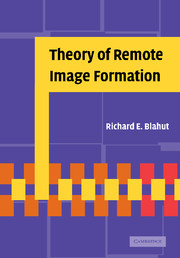Book contents
- Frontmatter
- Contents
- Preface
- Acknowledgements
- 1 Introduction
- 2 Signals in one dimension
- 3 Signals in two dimensions
- 4 Optical imaging systems
- 5 Antenna systems
- 6 The ambiguity function
- 7 Radar imaging systems
- 8 Diffraction imaging systems
- 9 Construction and reconstruction of images
- 10 Tomography
- 11 Likelihood and information methods
- 12 Radar search systems
- 13 Passive and baseband surveillance systems
- 14 Data combination and tracking
- 15 Phase noise and phase distortion
- References
- Index
10 - Tomography
Published online by Cambridge University Press: 19 August 2009
- Frontmatter
- Contents
- Preface
- Acknowledgements
- 1 Introduction
- 2 Signals in one dimension
- 3 Signals in two dimensions
- 4 Optical imaging systems
- 5 Antenna systems
- 6 The ambiguity function
- 7 Radar imaging systems
- 8 Diffraction imaging systems
- 9 Construction and reconstruction of images
- 10 Tomography
- 11 Likelihood and information methods
- 12 Radar search systems
- 13 Passive and baseband surveillance systems
- 14 Data combination and tracking
- 15 Phase noise and phase distortion
- References
- Index
Summary
Suppose that one is given several images of a two-dimensional (or a multidimensional) object, but that the detail of each of these images is limited in some way. For example, the images may be projections of a multidimensional object onto a lower-dimensional space. By using sophisticated signal-processing techniques, many such limited images of a common object can be combined to construct a single enhanced image.
Techniques for combining multiple one-dimensional projections into a single two-dimensional image are known collectively as tomography (Greek toma: a cut + graphy). The term may also be used to describe techniques for combining several poor images into a single improved image. This is different from the practice of enhancing a single image by signal-processing techniques, although, of course, the two tasks are closely related.
The most widespread form of tomography, known as projection tomography, reconstructs an image from its projections. Projection tomography has a simple mathematical structure. The most familiar instance of projection tomography uses X-rays as the source of illumination and X-ray absorption as the observed phenomenon. In this case, the way the X-ray illumination is used is quite different from the case of molecular imaging where the observation in the far field is based on scattering of the illuminating X-rays. In projection tomography, the observation is based on attenuation of the illuminating rays in the geometrical-optics approximation.
Information
- Type
- Chapter
- Information
- Theory of Remote Image Formation , pp. 321 - 360Publisher: Cambridge University PressPrint publication year: 2004
